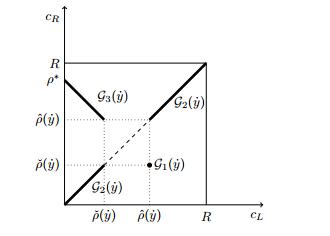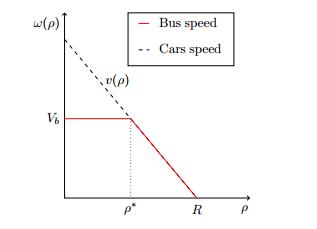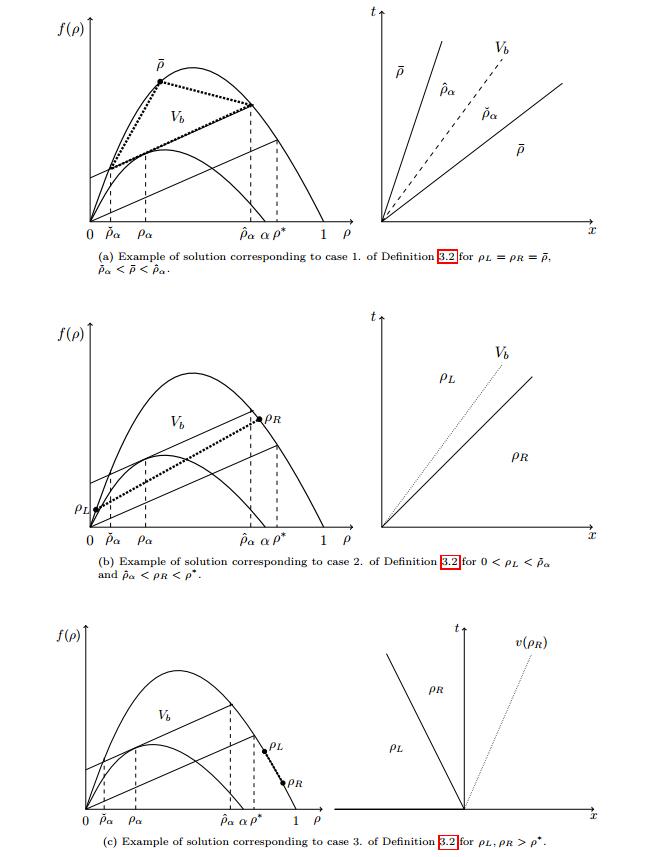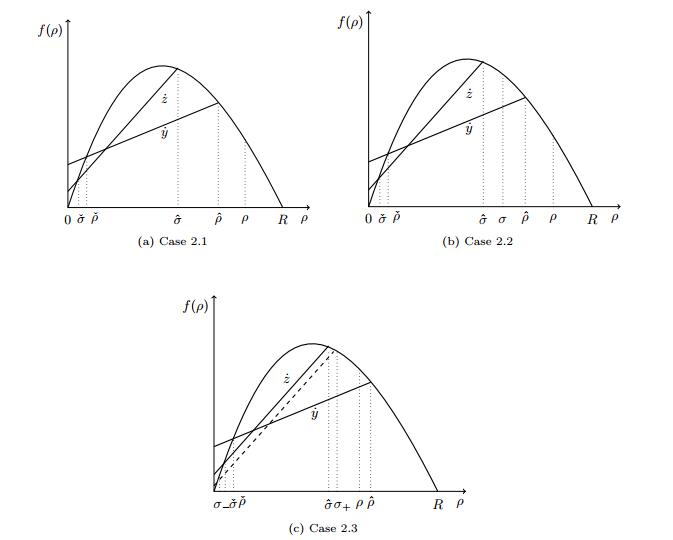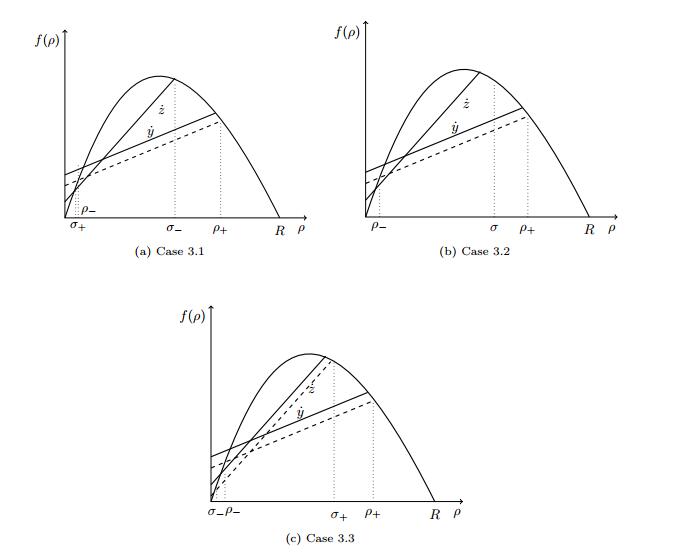1.
Introduction
Motivated by the modeling of moving bottlenecks in traffic flow, which can be caused by a large, slow moving vehicle, we consider the Cauchy problem for a scalar conservation law with moving flux constraint
where t↦y(t) is a given trajectory, starting from y(0)=y0, and
with ρα(˙y) such that f′(ρα(˙y)/α)=˙y. Systems of the form (1) arise in the modeling of moving bottlenecks in vehicular traffic [12,16]: ρ=ρ(t,x)∈[0,R] is the scalar conserved quantity and represents the traffic density, whose maximum attainable value is R. The flux function f:[0,R]→R+ is assumed to be strictly concave, Lipschitz continuous and such that f(0)=f(R)=0. The time-dependent variable y denotes the constraint position. In the present paper we consider a weakly coupled PDE-ODE system, in the sense that we assume that the constraint trajectory is given, and it does not depend on the solution of (1a).
Let us detail the meaning of inequality (1c). A moving flux constraint located at x=y(t) acts as an obstacle, thus hindering the flow as expressed by the unilateral constraint (1c). There, α∈ ]0,1[ is the dimensionless reduction rate of the road capacity (the maximal allowed density) at the bottleneck position. The inequality (1c) is derived by studying the problem in the constraint reference frame, i.e., setting ˜ρ(t,x):=ρ(t,x+y(t)) and rewriting the conservation law (1a) as
In fact, let fα:[0,αR]→R+ be the rescaled flux function describing the reduced flow at x=y(t), defined by fα(ρ)=αf(ρ/α), and let ρα(˙y)∈ ]0,αR[ such that
with Fα(ρ)=fα(ρ)−˙yρ, see Figure 1. Notice that, for (4) to have a solution in ]0,αR[, we will need to assume that ˙y(t)<f′(0) for t≥0. Then setting ˜Fα(˙y):=Fα(ρα(˙y)) we recover (2). Imposing that in the obstacle reference frame the flux F is less than the maximum value of the flux of the reduced flow, one gets (1c). Notice that the inequality (1c) is always satisfied if
since its left-hand side is 0. Moreover, it is well defined even if ρ has a jump at y(t), because of the Rankine-Hugoniot conditions.
Problem (3), (1b), (1c), can therefore be recast in the framework of conservation laws with fix local constraint, first introduced in [10], then developed in [2,4] for scalar equations and extended in [3,14,13] to systems. Following [12,Definition 4.1] and [6,Definition 1 and 2], solutions of (1) are defined as follows.
Definition 1.1. Let y∈W1,∞(R+;R) with 0≤˙y<f′(0) and ρ0∈L1∩L∞(R;[0,R]) be given. A function ρ∈C0(R+;L1(R;[0,R])) is a solution to (1) if
1. ρ satisfies Kružkov entropy conditions [15] on (R+×R)∖{(t,y(t)):t∈R+}, i.e. for every k∈[0,R] and for all φ∈C1c(R2;R+) and φ(t,y(t))=0, t>0,
2. for a. e. t>0 the left and right traces of ρ at x=y(t) satisfy
Notice that the left and right traces in (5b) do exist, see [4,Section 2].
The set Gα(˙y) in (5b) is defined as follows, see [4,5,6].
Definition 1.2. The admissibility germ Gα(˙y)⊂[0,R]2 for (1a), (1c) is the union Gα(˙y):=G1(˙y)∪G2(˙y)∪G3(˙y), where
We refer the reader to Figure 2 for a graphical representation of Gα(˙y)
The equivalence between Definition 1.1 and [12,Definition 4.1] can be proved as in [4,Proposition 2.6].
Systems of the type (1) arise in the modeling of moving bottlenecks in traffic flows, see [12,16] and Section 3 below, where they are coupled with an ODE depending on the downstream traffic velocity and describing the trajectory of a slow moving vehicle (a bus or a truck) acting as a bottleneck.
This paper is a first step towards establishing well-posedness for the strongly coupled models [12,16]. Section 2 presents the main result, stating the L1 Lipschitz continuous dependence of solutions of (1) from the initial data and the constraint trajectory. Section 3 describes in details the related traffic flow model with moving bottleneck. Technical proof details are deferred to Appendix A.
2.
Lipschitz continuous dependence of BV solutions with respect to ˙y
Let us fix the constraint trajectory y∈W1,∞(R+;R) with 0≤˙y<f′(0) and the initial datum ρ0∈BV(R;[0,R]), and let ρ∈C0(R+;L1(R;[0,R])) be a solution of (1) in the sense of Definition 1.1. Applying the coordinate transformation ˜ρ(t,x):=ρ(t,x+y(t)), ˜ρ is a weak entropy solution of the problem
in the sense of [4,Proposition 2.6(A)] where we have set F(˜ρ):=f(˜ρ)−˙y˜ρ. Existence and uniqueness for (6) are proved in [4,10]. In particular, we have that for every k∈[0,R] and for all φ∈C1c(R2;R+) such that φ(t,0)=0, t>0,
where we have set
and
see [4,Proposition 2.6]. Moreover, we note that, since α<1 and f is strictly concave, we have
Remark 1. Solution to (6) are not in BV in general (see [1,10]), but thanks to the strict inequality in (7) and since y∈W1,∞(R+;R) implies ˙y∈BVloc(R+), we can conclude that ˜ρ(t,⋅)∈BV(R;[0,R]) for any t>0, as in [12].
We compare solutions of (6) corresponding to different constraint trajectories y and z.
Theorem 2.1. Assume y,z∈W1,∞(R+;R), with 0≤˙y,˙z<f′(0), ˜ρ0,˜σ0∈L∞(R,[0,R]) and ˜ρ0−˜σ0∈L1(R). Let ˜ρ,˜σ∈C0(R+;L1(R;[0,R])) be solutions of (6) corresponding respectively to y,˜ρ0 and z,˜σ0. Moreover, let Ct=sups∈[0,t]TV(˜ρ(s,⋅)) be finite. Then we have
Proof. The two solutions ˜ρ, ˜σ satisfy
in D′(R+×R∗) (where we have noted R∗=R∖{0}). Following the proofs of [6,Lemma 15] and [7,Theorem 3.1] we observe that
therefore
Applying the classical Kružkov doubling of variables technique [15], with a test function ψ∈C1c(R2;R+) such that ψ(t,0)=0, we deduce the following Kato inequality
We now choose the test function ψ(t,x)=θε(x)ξ(t,x), where ξ∈C1c(R2;R+) is an approximation of the characteristic function of the trapezoid
(where L≥supρ∈[0,R],s∈[0,t]|f′(ρ)−˙z(s)| and M∈R, M>0) and θε a smooth approximation of x→min{|x|/ε,1}. Following the proof of [10,Proposition 4.4] and letting ε↘0 we get
By Lemma A.1, the last integrand can be bounded by
Letting M→∞, we recover (8).
We are now able to state the well-posedness of problem (1).
Corollary 1. Assume y,z∈W1,∞(R+;R), with 0≤˙y,˙z<f′(0), ρ0,σ0∈L∞(R,[0,R]) and ρ0−σ0∈L1(R). Let ρ,σ∈C0(R+;L1(R;[0,R])) be solutions of (1) corresponding respectively to y,ρ0 and z,σ0. Moreover, let Ct=sups∈[0,t]TV(ρ(s,⋅)) be finite. Then we have
Proof. Setting
for any t>0 we get
Therefore, by (8), we get
where we have used the estimate |y(t)−z(t)|≤|y(0)−z(0)|+∫t0|˙y(s)−˙z(s)|ds.
3.
Application to traffic modeling
Setting
where v(ρ)=V(1−ρ/R) is the mean traffic speed, V being the maximal velocity allowed on the road, problem (1) can be used to describe the situation of a moving bottleneck along a road, see [12]. In this case, we get fα(ρ)=Vρ(1−ραR) and ρα(˙y)=αR2(1−˙yV), so that
Let us suppose that a slow and large vehicle, like for example a bus or a truck moves on the road. The slow vehicle, that in the following we will refer as "the bus", reduces the road capacity and moves with a trajectory given by the following ODE:
where the velocity of the bus is given by the following traffic density dependent function (see Figure 3)
This means that if the traffic is not too congested, the bus moves at its own maximal speed Vb<V. When the surrounding traffic density becomes too high, the bus adapts its velocity accordingly. In particular, it is not possible for the bus to overtake the cars.
Solutions of the coupled system (1), (14) for general initial data are defined as follows.
Definition 3.1. A couple (ρ,y)∈C0(R+;L1(R;[0,R]))×W1,1(R+;R) is a solution to (1) if
1. ρ satisfies Kružkov entropy conditions [15] on (R+×R)∖{(t,y(t)):t∈R+}, i.e. for every k∈[0,R] and for all φ∈C1c(R2;R+) and φ(t,y(t))=0, t>0,
2. for a. e. t>0 the one-sided traces of ρ at x=y(t) satisfy
3. y is a Carathéodory solution of (14), i.e. for a.e. t∈R+
The proof of existence of solutions for the general Cauchy problem (1) strongly coupled with the bus trajectory (14) with BV initial data can be found in [12]. For completeness, we recall the definition of the solution of a Riemann problem, as given in [12]. Let us consider a Riemann type initial datum
Denote by R the standard (i.e., without the constraint (1c)) Riemann solver for (1a)-(1b)-(17), i.e., the (right continuous) map (t,x)↦R(ρL,ρR)(x/t) given by the standard weak entropy solution, see for instance [8,Chapter 5]. Moreover, assume that ˙y is constant and let ˇρ=ˇρ(˙y) and ˆρ=ˆρ(˙y), with ˇρ≤ˆρ, be the intersection points of the flux function f(ρ) with the line fα(ρα)+˙y(ρ−ρα) (see Figure 1(a)):
Definition 3.2. The constrained Riemann solver Rα:[0,R]2→Lloc1(R;[0,R]) corresponding to (1), (14), (17) is defined as follows.
1. If f(R(ρL,ρR)(Vb))>Fα+VbR(ρL,ρR)(Vb), then
2. If VbR(ρL,ρR)(Vb)≤f(R(ρL,ρR)(Vb))≤Fα+VbR(ρL,ρR)(Vb), then
3. If f(R(ρL,ρR)(Vb))<VbR(ρL,ρR)(Vb), i.e., v(R(ρL,ρR)(Vb))<Vb then
Note that, when the constraint is enforced (point 1. in the above definition), a non-classical shock arises between ˆρ(Vb) and ˇρ(Vb), which satisfies the Rankine-Hugoniot condition but violates the Lax entropy condition, see Figure 4 for an example.
Remark 2. Unfortunately, no result about the Lipschitz continuous dependence of the solution y=y(t) of (14) from the solution ρ=ρ(t,x) of (1) is known at present. Related results [9,11] concerning uniqueness and continuous dependence for ODEs of the form (14) hold under hypothesis on the speed function ω that are not satisfied by (15).
Appendix A. Proof of (12).
Lemma A.1 For any (ρ−,ρ+)∈Gα(˙y) and (σ−,σ+)∈Gα(˙z), it holds
Proof. First of all, let us remark that
where
Without loss of generality, we can assume ˙y<˙z. Therefore we get
We distinguish the following cases:
1. (ρ−,ρ+)∈G1(˙y): we observe that
Depending on the values of σ−, σ+, different situations can occur as shown in Figure 5:
1.1 (σ−,σ+)∈G1(˙z): in this case σ−=ˆσ, σ+=ˇσ, as shown in Figure 5a and f(σ−)−˙zσ−=f(σ+)−˙zσ+=Fα(˙z), therefore
1.2 (σ−,σ+)∈G2(˙z): we set
The following cases can occur:
● 0≤σ≤ˇσ:
● ˆσ≤σ≤ˆρ, see Figure 5b:
● ˆρ≤σ≤R:
1.3 (σ−,σ+)∈G3(˙z): we set
We observe that sgn(ρ+−σ+)<0 and sgn(ρ−−σ−)>0, see Figure 5c. Therefore
2. (ρ−,ρ+)∈G2(˙y): we set
as illustrated in Figure 6.
2.1 (σ−,σ+)∈G1(˙z):
● 0≤ρ≤ˇσ:
● ˇσ≤ρ≤ˇρ, this case is displayed in Figure 6a:
● ˆρ≤ρ≤R:
2.2 (σ−,σ+)∈G2(˙z), illustrated in Figure 6b:
We observe that sgn(ρ+−σ+)=sgn(ρ−−σ−)=sgn(ρ−σ), therefore
2.3 (σ−,σ+)∈G3(˙z) shown in Figure 6c: If sgn(ρ−σ+)=sgn(ρ−σ−), we get
Otherwise, we have that σ−≤ρ≤ˇρ or ˆρ≤ρ≤σ+. In this case
by the concavity of f. Therefore, (19)≤0 by (20).
3. (ρ−,ρ+)∈G3(˙y): we set
See Figure 7, for a graphical representation.
3.1 (σ−,σ+)∈G1(˙z), see Figure 7a.
3.2 (σ−,σ+)∈G2(˙z): If sgn(ρ+−σ)=sgn(ρ−−σ), we get
Otherwise as shown in Figure 7b, we have that ρ−≤σ≤ˇσ or ˆσ≤σ≤ρ+. In this case
Moreover, we observe that λ(ρ−,σ−)>˙y. Indeed
Therefore, by (20)
3.3 (σ−,σ+)∈G3(˙z):
We observe that one of the following relations must hold
For an example see Figure 7c. Therefore
again by concavity of f. Hence (19)≤0 by (20).
Acknowledgments
The authors are grateful to Boris Andreianov for suggesting links with the results in [6]. The authors also thank the two anonymous referees for the careful revision and the insightful comments, which were of great help in improving the paper.
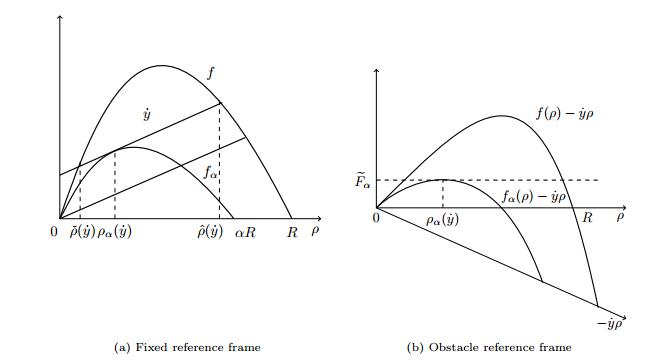









 DownLoad:
DownLoad:
